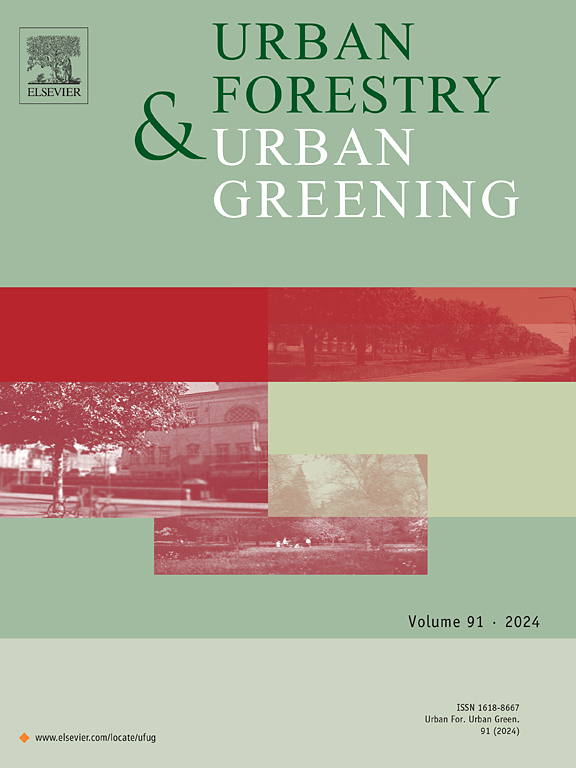影响中国广州老城区行道树树根与种植坑和人行道冲突的关键因素
IF 6
2区 环境科学与生态学
Q1 ENVIRONMENTAL STUDIES
引用次数: 0
摘要
城市行道树能提高城市生活质量,但其根系可能与基础设施发生冲突,尤其是在人口稠密地区。广州--世界上人口最稠密的城市之一--面临着与行道树根系破坏有关的重大挑战,这影响了城市基础设施和公共安全。本研究考察了影响广州老城区 1,227 棵行道树根系损伤的因素,重点关注树木表型参数、种植环境和根系特征。记录的变量包括树高(TH)、冠幅(CW)、胸径(DBH)、根系分布、是否存在支根以及种植坑大小。逻辑回归确定了影响根损发生和严重程度的关键因素。结果显示,30.9%的树木出现了根系损伤。浅根树种(如小叶榕和榕树)的根系损伤率更高(分别为 41% 和 47%)。主要预测因素包括 DBH、种植坑大小和支根。DBH 与根系损伤呈正相关;较大的种植坑可降低根系损伤的风险;而盘根则增加了根系损伤的可能性。有盘根的树木更容易造成严重损害,而 DBH > 40 厘米的树木容易造成中度和严重损害。这些发现为城市规划者和林业管理者优化树木选择和种植策略、减轻根系损害和提高城市基础设施的恢复能力提供了宝贵的见解。本文章由计算机程序翻译,如有差异,请以英文原文为准。
Key Factors Influencing Street Tree Root Conflicts with Planting Pits and Sidewalks in Old Guangzhou, China
Urban street trees improve urban life quality, but their root systems can conflict with infrastructure, especially in densely populated areas. Guangzhou—one of the world’s most densely populated cities—experiences significant challenges related to street tree root-damage, which impacts urban infrastructure and public safety. This study examined factors affecting root-damage in 1,227 street trees in Guangzhou’s old urban areas, focusing on tree phenotypic parameters, planting environment, and root characteristics. Variables recorded included Tree height (TH), Crown width (CW), Diameter at breast height (DBH), root distribution, presence of buttress roots, and planting pit size. Logistic regression identified key factors influencing root-damage occurrence and severity. Results showed 30.9% of trees exhibited root-damage. Shallow-rooted species such as Ficus microcarpa and Ficus altissima had higher root-damage rates (41% and 47%, respectively). Key predictors included DBH, planting pit size, and buttress roots. DBH was positively correlated with root-damage; larger planting pits reduced root-damage risk; and buttress roots increased root-damage likelihood. Trees with buttress roots were more likely to cause severe damage, and trees with DBH > 40 cm were prone to moderate and severe damage. These findings offer valuable insights for urban planners and forestry managers to optimize tree selection and planting strategies, mitigating root-damage and enhancing urban infrastructure resilience.
求助全文
通过发布文献求助,成功后即可免费获取论文全文。
去求助
来源期刊

Urban Forestry & Urban Greening
FORESTRY-
CiteScore
11.70
自引率
12.50%
发文量
289
审稿时长
70 days
期刊介绍:
Urban Forestry and Urban Greening is a refereed, international journal aimed at presenting high-quality research with urban and peri-urban woody and non-woody vegetation and its use, planning, design, establishment and management as its main topics. Urban Forestry and Urban Greening concentrates on all tree-dominated (as joint together in the urban forest) as well as other green resources in and around urban areas, such as woodlands, public and private urban parks and gardens, urban nature areas, street tree and square plantations, botanical gardens and cemeteries.
The journal welcomes basic and applied research papers, as well as review papers and short communications. Contributions should focus on one or more of the following aspects:
-Form and functions of urban forests and other vegetation, including aspects of urban ecology.
-Policy-making, planning and design related to urban forests and other vegetation.
-Selection and establishment of tree resources and other vegetation for urban environments.
-Management of urban forests and other vegetation.
Original contributions of a high academic standard are invited from a wide range of disciplines and fields, including forestry, biology, horticulture, arboriculture, landscape ecology, pathology, soil science, hydrology, landscape architecture, landscape planning, urban planning and design, economics, sociology, environmental psychology, public health, and education.
 求助内容:
求助内容: 应助结果提醒方式:
应助结果提醒方式:


